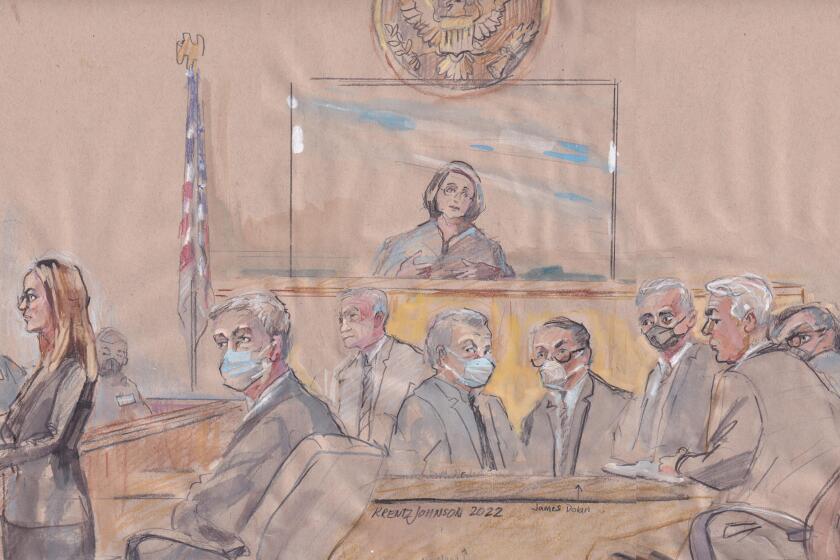Trump touts VA overhaul, but affected workers say the result has not been good for veterans
A trio of executive orders signed by President Trump in May to take on what he considers a bloated and inefficient federal workforce are working as intended, administration officials say, although Department of Veteran Affairs workers and union members say the implementation is hurting workers — and veterans.
The workers and union members say the orders, in combination with a new VA accountability law signed by Trump last year, are creating choas and hurting morale. A VA spokesman said the new rules are holding employees accountable for their performance — or lack thereof.
The president touted the success in comments to the Veterans of Foreign Wars national convention in July, pointing to the number of fired employees as a benchmark for progress.
“We’ve gotten rid of a lot of people over the last year,” he said. “Only the bad ones. The good ones we cherish.”
On July 20, the VA announced it had implemented one of the three orders orders Trump signed restricting union leaders from doing union business on official time, funded by taxpayers. The VA said the changes are freeing up employees to spend more serving for veterans rather than “union bosses.”
Union leaders say they are serving their members and the agency at large with the union work they do on official time — by performing human resources-related functions such as contract disputes, leave requests and filing grievances.
A change in the law
In June 2017, Trump signed the Department of Veterans Affairs Accountability and Whistleblower Protection Act into law, changing the process by which the VA reviews employee performance deficiencies as well as the time frames within which the agency must address them.
The department, which serves the nation’s roughly 20 million veterans, had been under pressure to shorten the wait times in claims processing and at its medical centers.
Although Trump promotes the firings made possible under the law, VA employees — speaking in their capacity as union leaders — said they have hurt morale throughout the agency.
Anthony Gallagher, the president of the San Diego chapter of the union, reviews disability claims at the Veterans Benefits Administration. He serves about 625 VA workers.
Gallagher described an agency at war with its own employees. He said that since the accountability law was passed, he’s been in a constant battle to protect his members.
“They’re taking away our rights for due process that are in our (union) contract,” he said. “Basically, the (law) has turned us into at-will employees.”
Another benefits rating specialist, Jim Rihel, serves as the AFGE president in Philadelphia. He said it is as though the VA is determined to fire as many employees as possible.
“We’re spending more time worrying about our jobs than doing them,” he said.
Thousands fired
The VA employs more than 300,000 people. According to the latest numbers from the VA, as of the end of June, 2,743 employees have been fired since Trump took office.
David Cox Sr., the national president of the 700,000-member American Federation of Government Employees, said the firings are harming veterans — and not improving the agency.
“I don’t know any business that has fired its way to success,” he said.
Of the fired employees, 60 held supervisory job titles, including former department secretary David Shulkin, who was fired in March.
The agency’s press secretary, Curt Cashour, said restructuring under the new law has resulted in improved performance in the benefit administration.
“When it comes to compensation and pension rating claims, VA has reduced the average completion time from 113 days to 99 days,” he said in an email.
Lee Blackmon, the federal director of the National Association of Government Employees — another federal workers union — said the firings were affecting morale and patient care.
“Employees are under stress, tension increases (and) call-outs go up,” she said. “It’s not a happy or good place to work right now. If you feel threatened, what kind of care can you give?”
The new accountability law simplified the process for terminating VA employees and, according to Gallagher, the agency is not acting in good faith in its assessment of employee performance.
Gallagher said workers they represent had their job descriptions changed without being notified, then were written-up for not performing up to those new standards.
“They’ll change the standard without telling you, without testing it,” Gallagher said. “If you change the (job) description, you change the requirement that you had...or they make it so high that you can’t do it.”
Cashour denied the agency changed workers’ job descriptions without notification.
“That’s false,” he said in an email.
An agency in ‘chaos’
The three executive orders Trump signed in May directed federal agencies to aggressively negotiate labor contracts, further streamlined the firing process and put strict limits on “official time” — taxpayer funding of union work done at the agency, which was authorized in the Civil Service Reform Act of 1978.
More than a dozen unions have sued the Trump Administration, claiming the orders violate the 1978 law.
Arguments were heard in July, and a judge is expected to rule Aug. 24.
Previously, employees in leadership positions in the union might devote up to 100 percent of their workdays performing union-related work. Under the new rules, no more than 25 percent of official time may be used for union business.
In an email, Cashour said the Trump administration is protecting taxpayers and ensuring more paid VA time is spent serving veterans.
“Prior to this executive order, VA employees spent more than a million hours a year doing taxpayer-funded work for union bosses instead of taking care of veterans,” Cashour said. “This policy will expand VA’s ability to provide patient care by ensuring employees… will be spending more of their time placing veterans — not union bosses — first in everything they do.”
Gallagher, who until recently was one of those “100 percent” official time employees, said his work conducting union business focused on serving VA employees, not “union bosses.”
“A lot of work is in reporting deficiencies in health and morale,” he said, adding that he used to help employees — union and non-union — file grievances, but that the new orders now forbid him from doing so.
Gallagher also said the VA had botched implementation of the order.
“They have no plan,” he said. “It’s causing chaos.”
Cashour disagreed.
“The implementation is going very well,” he said, noting that guidance was sent to VA facilities as recently as July 17.
‘A red herring’
A recent report by ProPublica detailed how three members of Trump’s Mar-a-Lago club in Florida were secretly shaping policy at VA by communicating with officials daily on policy and personnel decisions.
Democrats in Congress condemned the report, saying they would investigate private interference in the agency. The liberal veterans organization VoteVets on Thursday sued the Trump Administration, claiming that the “Mar-a-Lago Council is violating federal laws that regulate the ability of private interests to shape federal policy.”
Iraq and Afghanistan Veterans of America, a veteran advocacy nonprofit, supported last year’s accountability law and supports the firing of “bad-performing” employees, but a spokesman said the group has noticed the department’s current chaotic conditions.
“We see that,” said Tom Porter, IAVA’s legislative director. “A lot of employees (are) leaving, the result of that hurts vets. We need stability at the VA to help vets, not meet a political agenda.”
Porter said that agenda is privatization of the VA. Former Secretary Shulkin told NPR in March that there were political forces at work in the department, and that his firing was connected to his resistance to privatization.
The VA has posted a statement on its website saying there is no such push.
“There is no effort underway to privatize VA,” it says, “and to suggest otherwise is completely false and a red herring designed to distract and avoid honest debate on the real issues surrounding Veterans’ health care.”
Get Essential San Diego, weekday mornings
Get top headlines from the Union-Tribune in your inbox weekday mornings, including top news, local, sports, business, entertainment and opinion.
You may occasionally receive promotional content from the San Diego Union-Tribune.










